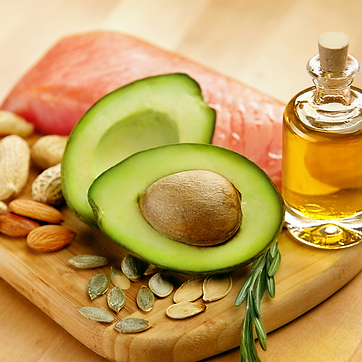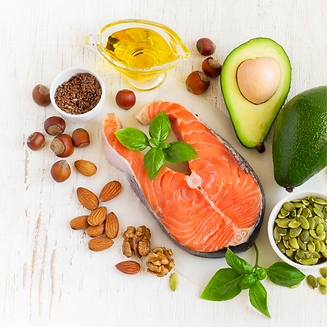
Dietary Fats
Fats are high in calories and may contribute to weight gain and put you at risk for diseases such as Heart Disease. It is recommended that people over 2 years of age, reduce their consumption of calories from solid fats and saturated fat levels. Fats are often categorized into 4 main types: monounsaturated fats, polyunsaturated fats, trans fats and saturated fats.
Fats Defined
Unsaturated fats
Include monounsaturated fat and polyunsaturated fat. These are considered the "good" fats. Consumption of unsaturated fats are encouraged as part of a healthy diet. They can have positive effects on cholesterol level, reducing the risk of heart disease. Polyunsaturated fats are good sources of omega-3 fatty acids, which are for a healthy diet.
Trans fats
These are considered the "bad" fats because they are associated with an increased risk of heart disease and stroke. Trans fats can be found in foods naturally, but for the most part are created as part of food processing.
Saturated fats
Saturated fats are found naturally in meats and dairy sources, especially red meat and butter. Saturated fats have been associated with an increased risk of heart disease and stroke and should be eaten in moderation. The USDA recommends eating no more than 20 grams per day.
Did You Know?
In general, fat intake is recommended not to exceed 20% - 35% of total daily calories. Saturated fat should not exceed 7% of total calories. The specific amount of fats recommended for your diet depends on your age, sex and physical activity.

Food Examples of Fats
Monounsaturated Fats
-
Avocados
-
Olives
-
Nuts
-
Peanut Butter
Polyunsaturated Fats
-
Fatty fish (salmon, tuna, sardines)
-
Sunflower, sesame and pumpkin seeds
-
Walnuts
-
Tofu
-
Soymilk
Omega 3 Fatty Acids
-
Salmon
-
Herring
-
Mackerel
-
Anchovies
-
Oysters
-
Sardines
-
Tuna
-
Fish Oil
-
Walnuts
-
Flaxseed
-
Brussel Sprouts
-
Kale
-
Spinach
Trans Fats
-
Packaged snacks (crackers, microwave popcorn, chips, candy)
-
Solid fats (stick margarine, vegetable shortening)
-
Fried foods (french fries, fried chicken, chicken nuggets)
-
Pre-mixed products (cake mix, pancake mix)
-
Commercially baked goods (cookies, crackers, cakes, muffins, pie crust, pizza dough, breads)
Saturated Fats
-
Meat and Poultry
-
Butter
-
Cream
-
Milk
-
Cheese
-
Coconut Oil
How can you reduce the amount of fat you eat?
-
Choose low-fat or fat free dairy products, like milk, cheese and yogurt
-
Bake, grill or broil food when cooking, avoid frying
-
Use non-stick cooking spray rather than oil when cooking
-
Choose lean meats, fish and poultry
-
Trim all visible fat and remove skin from meats